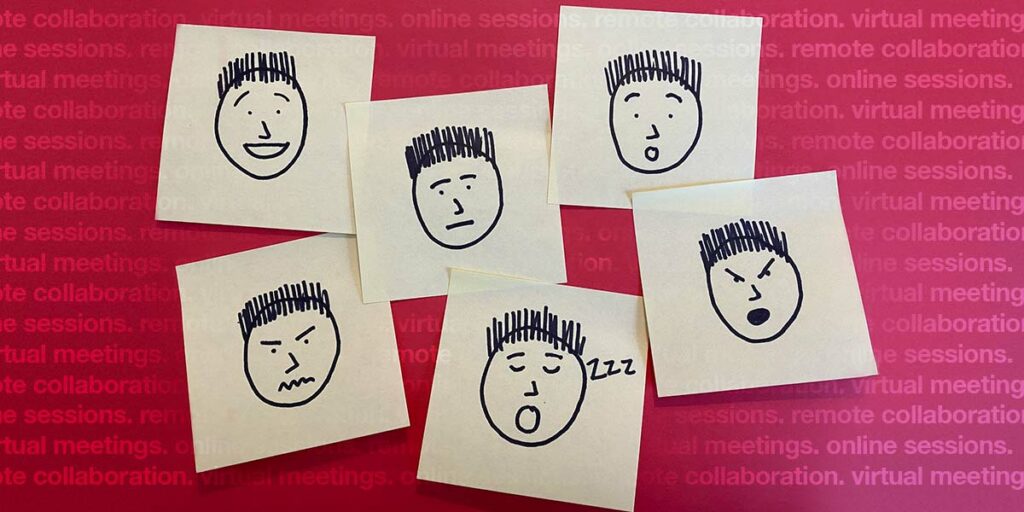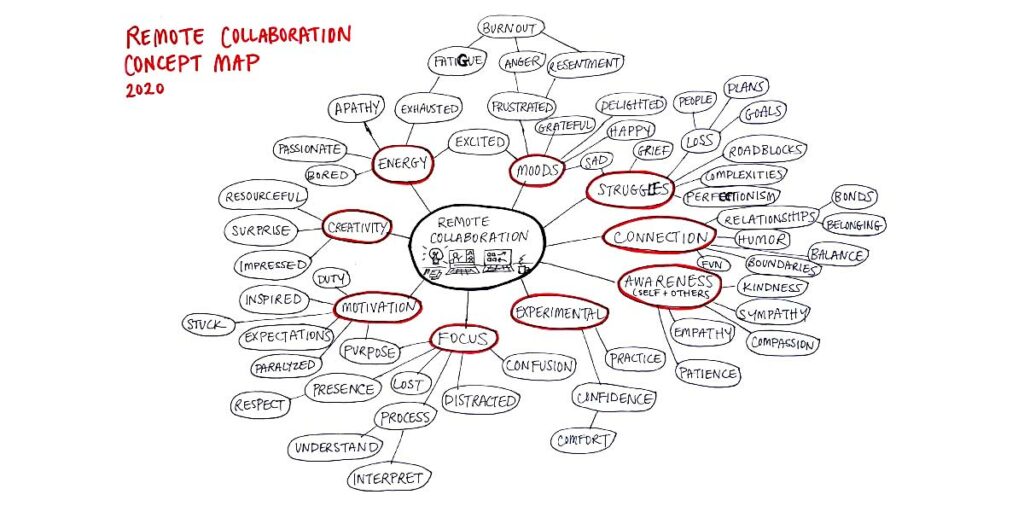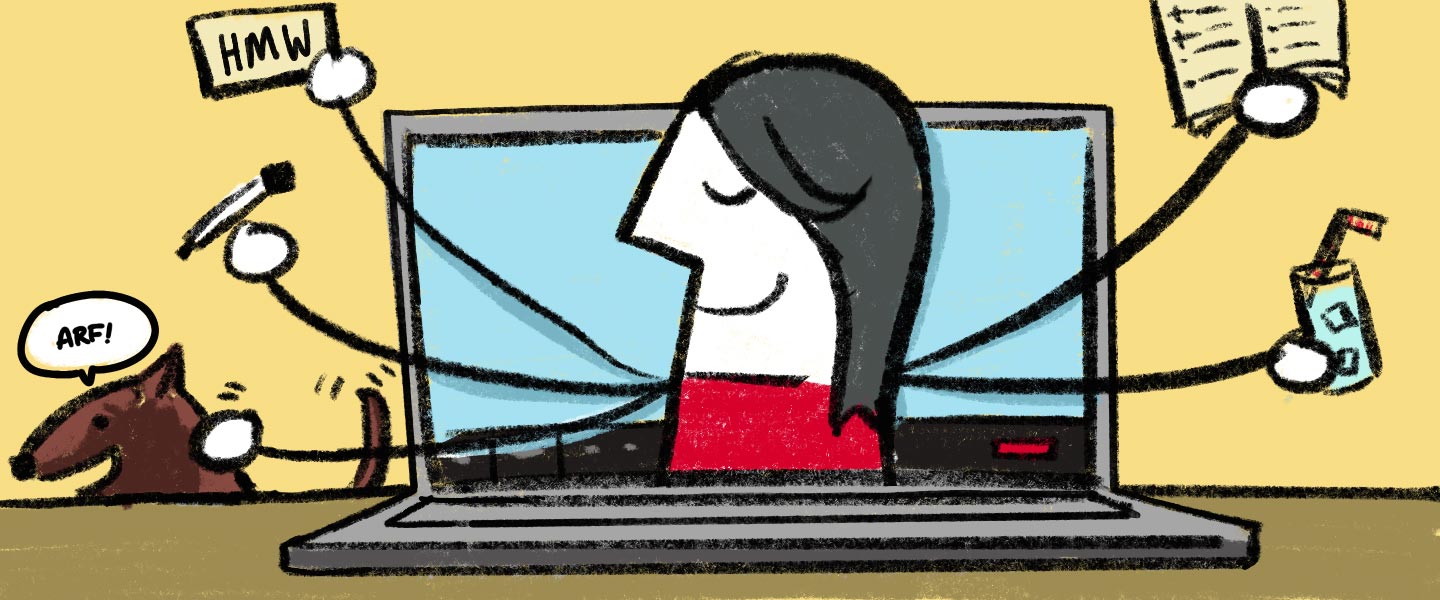Remote collaboration.
Virtual meetings.
Online sessions.
What comes to mind when you hear these seemingly simple, innocent phrases? I imagine they might spark a mix of complex emotions:

On one hand, you may feel a sense of dread, apathy, fatigue, stress and/or frustration over your most recent remote engagements. On the other hand, you may feel delight, satisfaction, excitement, and/or pride as you reflect on what you and your team have been able to accomplish across distances, time zones, tools, and technologies. Sometimes, we can feel all of the above in a single day!
Whether or not you worked remotely pre-pandemic, February 2020 marks a period of immense disruption, overwhelming change, and massive uncertainty and fear for many. We had to face constraints both new and old. We found ways to embrace the pivot, and make work, work.
Today, companies, organizations, and business owners continue to navigate these challenges with distributed teams. Many are balancing varying levels of ability and comfort of employees when facing a possible return to shared workspaces or new hybrid models that mix remote and in-person. But, remote work is ultimately here to stay in some capacity.
Given that reality, how might we create a future that yields more positive, pleasant emotions and outcomes from collaboration across distances?
Common challenges that unite us
Over the past 16 months, the team at LUMA has observed and discussed remote work with thousands of human-centered design practitioners around the world. Throughout this time, we deepened our understanding of their core needs and challenges as they tried harder than ever before to innovate from their homes and workspaces, amidst personal challenges, family responsibilities, and health scares.
Many powerful themes emerged from these stories. Here’s a Concept Map that showcases key needs, feelings, struggles, and goals relating to remote collaboration straight from our LUMA Community’s experiences:

What themes from the Concept Map resonate most with you?
What would your personal map on the topic look like?
As a self-identified super extrovert who works from a home office with her dog all day, the nodes “Energy” and “Connection” are often at the top of my radar. I am constantly taking short pauses and exhale moments throughout my work day to decompress and recharge, and I use What’s On Your Radar to unpack and organize my full brain. I find activities such as at-home yoga and the bullet journal method helpful to maintain focus and motivation. Many of my peers would tell you that I could not survive without connecting with others via Slack! Joking aside, I feel fortunate to have discovered these tactics for myself, as it can be a challenge for many of us to find the ones that work.
It has been heartbreaking to repeatedly hear people articulate these struggles when teaching LUMA programs and courses over the last year. I interacted with those who either felt disempowered to take action or had a lack of clarity on how to take those first vital steps toward making remote work better.
However, it is worth noting that some who shared their stories were already living a happy and fulfilling remote work life – I was, and I still am! The main challenges they vocalized were instead around helping our teammates transition to new ways of collaborating and communicating.
We at LUMA find it helpful to think of creating positive remote work changes through a series of steps, rather than trying to solve a wicked problem all at once. That brings us to the obvious question: now what?
Time to make positive change happen
Now can be a time of growth, rebirth, and healing, if we set up the right environment for people to thrive! As optimism and hope blossom, it is important to continue to share and take action toward our visions for brighter, happier, well-balanced futures.
Following is a series of Statement Starters you can choose from to kick off an ideation session with others, plus some experiment ideas you can test out to see what works best for you and your team. Or, come up with your own to try!
On behalf of the LUMA Community, I hope you and your team can find what experiments and pathways work best for you – based on where you are and where you want to be. If you find something that changed your remote work life for the better, we’d love to hear your story: email us at communications@luma-institute.com.
Let’s work together to make remote work better!

How might we counterbalance exhaustion and energize ourselves and others?
People are running on a daily energy deficit more severe than ever before. Video conference and meeting fatigue has taken a toll, and this compounded exhaustion could lead to individual and team burnout if left unchecked.
Statement Starters:
- In what ways might we re-energize to enable everyone to do their very best work?
- How might we add more energy to each other’s batteries than we take away?
- How might we collaborate with others without scheduling another live meeting?
Experiment Ideas:
- Mix different meeting formats into your schedule that feature more two-way engagement, e.g. hands-on working sessions, Critique sessions, etc.
- Practice flowing back and forth between asynchronous work (apart) and synchronous work (together).
- Break up longer LUMA recipes into multiple, shorter sessions of 1-3 methods at a time.
- Take short breaks from your screens and workspace throughout the day, setting an alarm or calendar reminder.
- Before sending a meeting invite, ask yourself, “Does this need to be a meeting?”

How might we foster more personal connections and community at work?
People crave relationships and connections. The transition to remote work has been especially hard for those who previously used a shared workspace every week and/or those who gain energy and happiness through human interaction. It takes intentional effort to help teammates around the world feel more seen and valued, and less alone and isolated.
Statement Starters:
- In what ways might we help employees feel more connected than ever before?
- How might we enable employees to share and celebrate more of their full selves at work?
- How might we maintain and strengthen team bonds remotely?
Experiment Ideas:
- Create a Concept Map to visualize the shared interests, passions, and hobbies on a team.
- Test out some virtual team-bonding ideas, such as trivia or game nights, a book club, virtual field trips, recipe exchanges, etc.
- Use a Concept Ideation method, like Creative Matrix or Round Robin, to invite team-building ideas from colleagues.
- Include brief warm-up activities or icebreakers at the start of your meetings.
- Schedule short, virtual coffee/tea chats or lunch breaks with colleagues you see less often.

How might we find better balance as we face competing priorities?
Work-life balance has become more difficult since many work spaces have blended into home spaces. People are constantly juggling competing priorities across the many “hats” they wear each day: parent, coworker, partner, spouse, sibling, roommate, family member, teacher, caregiver, friend. Old boundaries were broken and need repairing; new boundaries are desperately needed.
Statement Starters:
- How might we juggle the day’s priorities with the grace of a circus performer?
- In what ways might we transition smoothly in and out of the work day without having a commute as a buffer?
- How might we clearly signal to our teammates the moments when we are unavailable?
Experiment Ideas:
- Use Rose, Thorn, Bud or What’s On Your Radar to reflect on work-life balance to identify areas of greatest potential.
- Use status updates, out-of-office messages, or calendar blocks to signal to others when you are on a screen break, focusing on family needs, or prioritizing self-care.
- Align upon which communication channels to use for different kinds of work scenarios, questions, and needs.
- Establish positive boundaries for greater team happiness, such as keeping lunch breaks open when possible, no weekend or night time email expectations, etc.
- Try tactics like calendar reminders, phone alarms, or a desk cleaning ritual to trigger your brain to transition out of the work day.

How might we engage and be truly present with others?
Since our days are often filled with back-to-back meetings, it is more difficult to get – and keep – the time and engagement of others. Given the fatigue of constant task-switching, it is mentally challenging to fully show up and be present for each other. We must get creative to spot important context clues to effectively read the virtual room and adapt accordingly.
Statement Starters:
- How might we make sessions so engaging that people beg to attend?
- In what ways might we fully focus on the task of the moment and minimize distractions?
- How might we help others feel listened to, heard, and understood?
Experiment Ideas:
- Offer a quick bathroom break or beverage refill for the first few minutes of your meeting. (People will thank you!)
- Close or minimize any browser tabs and desktop apps that do not relate to the current topic.
- Lean on video conferencing chat to post discussion prompts and increase participation and equal voice.
- If internet connection is not an issue, ask everyone to go “camera-on” as default.
- Clearly note the objectives and desired outcomes in meeting invites so people know how to come prepared.

How might we get motivated and stay focused?
A dizzying array of distractions constantly threaten to knock us out of our focus and flow. Due to the greater level of exhaustion, getting and staying motivated is hard. Competing tasks can cause people to feel like they ran a marathon but did not get to the finish line on anything that matters.
Statement Starters:
- How might we use the five senses to bring calm, pleasure, and focus to our workspace?
- In what ways might we stay focused on a task like a moth to a flame?
- How might we get excited to work toward our “north stars” every day?
Experiment Ideas:
- Try Importance/Difficulty Matrix or Bull’s-eye Diagramming to bring focus to what’s most vital and important right now amidst the chaos of your day.
- Pause notifications and update your status during meetings and deep work.
- Start or end your day with a few minutes of short-form Journaling to clear your mind, such as the Two Minute Mornings approach.
- Use timers and timeboxing to focus on a single task at a time.
- Try keeping a bullet journal or use mobile or desktop apps to track your tasks and goals all in one place.

